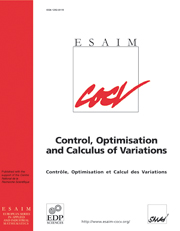Crossref Citations
This article has been cited by the following publications. This list is generated based on data provided by
Crossref.
Rosier, Lionel
and
de Teresa, Luz
2011.
Exact controllability of a cascade system of conservative equations.
Comptes Rendus. Mathématique,
Vol. 349,
Issue. 5-6,
p.
291.
Alabau-Boussouira, Fatiha
and
Léautaud, Matthieu
2011.
Indirect controllability of locally coupled systems under geometric conditions.
Comptes Rendus. Mathématique,
Vol. 349,
Issue. 7-8,
p.
395.
Alabau-Boussouira, Fatiha
2012.
Control of Partial Differential Equations.
Vol. 2048,
Issue. ,
p.
1.
Fu, Xiaoyu
2012.
Sharp Decay Rates for the Weakly Coupled Hyperbolic System with One Internal Damping.
SIAM Journal on Control and Optimization,
Vol. 50,
Issue. 3,
p.
1643.
Alabau-Boussouira, Fatiha
and
Léautaud, Matthieu
2013.
Indirect controllability of locally coupled wave-type systems and applications.
Journal de Mathématiques Pures et Appliquées,
Vol. 99,
Issue. 5,
p.
544.
Benabdallah, Assia
Boyer, Franck
González-Burgos, Manuel
and
Olive, Guillaume
2014.
Sharp Estimates of the One-Dimensional Boundary Control Cost for Parabolic Systems and Application to the $N$-Dimensional Boundary Null Controllability in Cylindrical Domains.
SIAM Journal on Control and Optimization,
Vol. 52,
Issue. 5,
p.
2970.
Li, Tatsien
Rao, Bopeng
and
Hu, Long
2014.
Exact boundary synchronization for a coupled system of 1-D wave equations.
ESAIM: Control, Optimisation and Calculus of Variations,
Vol. 20,
Issue. 2,
p.
339.
Özer, Ahmet Özkan
2015.
Further stabilization and exact observability results for voltage-actuated piezoelectric beams with magnetic effects.
Mathematics of Control, Signals, and Systems,
Vol. 27,
Issue. 2,
p.
219.
Aloui, L.
and
Daoulatli, M.
2016.
Stabilization of two coupled wave equations on a compact manifold with boundary.
Journal of Mathematical Analysis and Applications,
Vol. 436,
Issue. 2,
p.
944.
Alabau-Boussouira, Fatiha
Coron, Jean-Michel
and
Olive, Guillaume
2017.
Internal Controllability of First Order Quasi-linear Hyperbolic Systems with a Reduced Number of Controls.
SIAM Journal on Control and Optimization,
Vol. 55,
Issue. 1,
p.
300.
Oquendo, Higidio Portillo
and
Raya, Raul Prado
2017.
Best rates of decay for coupled waves with different propagation speeds.
Zeitschrift für angewandte Mathematik und Physik,
Vol. 68,
Issue. 4,
Zhao, Xiaowei
and
Weiss, George
2017.
Stability Properties of Coupled Impedance Passive LTI Systems.
IEEE Transactions on Automatic Control,
Vol. 62,
Issue. 11,
p.
5769.
Guglielmi, Roberto
2017.
Indirect stabilization of hyperbolic systems through resolvent estimates.
Evolution Equations & Control Theory,
Vol. 6,
Issue. 1,
p.
59.
Zhu, Xianzheng
2019.
Stability of the weakly coupled wave system with hybrid boundary conditions.
p.
1125.
Paunonen, Lassi
2019.
Stability and Robust Regulation of Passive Linear Systems.
SIAM Journal on Control and Optimization,
Vol. 57,
Issue. 6,
p.
3827.
Rao, Bopeng
2019.
On the sensitivity of the transmission of boundary dissipation for strongly coupled and indirectly damped systems of wave equations.
Zeitschrift für angewandte Mathematik und Physik,
Vol. 70,
Issue. 3,
Kassem, Chiraz
Mortada, Amina
Toufayli, Layla
and
Wehbe, Ali
2019.
Local indirect stabilization of N–d system of two coupled wave equations under geometric conditions.
Comptes Rendus. Mathématique,
Vol. 357,
Issue. 6,
p.
494.
Portillo Oquendo, Higidio
and
Sobrado Suárez, Fredy Maglorio
2019.
Exact decay rates for coupled plates with partial fractional damping.
Zeitschrift für angewandte Mathematik und Physik,
Vol. 70,
Issue. 3,
Oliveira, Rafael L.
and
Oquendo, Higidio P.
2020.
Stability and instability results for coupled waves with delay term.
Journal of Mathematical Physics,
Vol. 61,
Issue. 7,
Hao, Jianghao
and
Rao, Bopeng
2020.
Influence of the hidden regularity on the stability of partially damped systems of wave equations.
Journal de Mathématiques Pures et Appliquées,
Vol. 143,
Issue. ,
p.
257.




